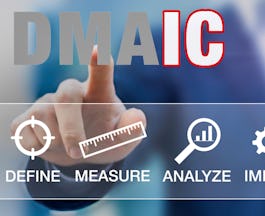82 results for "six sigma"

Google
Skills you'll gain: User Experience, User Experience Design, User Research, Audit, Human Computer Interaction, Planning, Product Design, Product Development, Visual Design, Web Design, Web Development Tools

Rutgers the State University of New Jersey
Skills you'll gain: Supply Chain Systems, Supply Chain and Logistics, Planning, Strategy and Operations, Inventory Management, Leadership and Management, Operations Management, Continuous Delivery, Data Analysis, Estimation, Forecasting, Microsoft Excel, Spreadsheet Software, Statistical Analysis, Strategy, Supplier Relationship Management, Warehouse Management, Operational Analysis, Probability & Statistics, Process Analysis, Product Management, Transportation Operations Management, Material Handling, Shipping and Receiving

University of Illinois at Urbana-Champaign
Skills you'll gain: Leadership and Management, Accounting, Management Accounting, Account Management, Cost Accounting, Decision Making, Financial Accounting, Financial Analysis, Marketing Management, Marketing, Media Strategy & Planning, Financial Management, Strategy, General Accounting, Brand Management, Market Research, Planning, Budget Management, Communication, Product Management, Market Analysis, Design and Product, Supply Chain and Logistics, Business Research, Probability & Statistics, Operations Management

University System of Georgia
Skills you'll gain: Entrepreneurship, Strategy and Operations, Leadership and Management, Business Process Management, Marketing, Performance Management, Sales, Strategy, Operations Management, Supply Chain and Logistics

University System of Georgia
Skills you'll gain: Decision Making, Leadership and Management, Operational Analysis, Organizational Development, Planning, Process Analysis, Data Analysis, Operations Management, Problem Solving, Project Management

Emory University
Skills you'll gain: Leadership and Management, Business Communication, Critical Thinking, Problem Solving, Decision Making, Strategy, Business Development, Business Intelligence, Communication, Market Research, Data Analysis, People Analysis, People Management, Process Analysis, Project Management, Strategy and Operations, Data Management

SkillUp EdTech
Skills you'll gain: Data Analysis, Exploratory Data Analysis, Problem Solving

University of Pennsylvania
Skills you'll gain: Accounting, Finance, General Accounting, Decision Making, Financial Accounting, Strategy and Operations, Account Management, Accounts Payable and Receivable, Cost Accounting, Leadership and Management, Strategy, Cash Management, Communication, Financial Analysis, Generally Accepted Accounting Principles (GAAP), Marketing, Brand Management, Budget Management, Customer Analysis, Market Analysis, Marketing Design, Product Marketing, Product Strategy, Entrepreneurship, Human Resources, People Analysis, Performance Management, Business Analysis, Customer Relationship Management, Mathematical Theory & Analysis, Change Management, Human Resources Operations, Talent Management, Planning, Operations Management

University System of Georgia
Skills you'll gain: Probability & Statistics, Statistical Analysis, Data Analysis, General Statistics, Mathematics, Statistical Tests, Statistical Visualization, Organizational Development, Probability Distribution, Data Visualization

University System of Georgia
Skills you'll gain: Data Analysis, General Statistics, Probability & Statistics, Basic Descriptive Statistics, Experiment, Interactive Data Visualization, Interactive Design, Mathematical Theory & Analysis, Problem Solving, Statistical Visualization

University System of Georgia
Skills you'll gain: Leadership and Management, Strategy and Operations, Operations Management, Organizational Development, Planning, Project Management, Customer Success, Operational Analysis, Problem Solving, Process Analysis
 Status: Free
Status: FreeUniversity of Michigan
Skills you'll gain: Critical Thinking
In summary, here are 10 of our most popular six sigma courses
- Google UX Design: Google
- Supply Chain Management: Rutgers the State University of New Jersey
- Value Chain Management: University of Illinois at Urbana-Champaign
- Organization Planning and Development for the 6 σ Black Belt: University System of Georgia
- Six Sigma Advanced Improve and Control Phases: University System of Georgia
- Management Consulting: Emory University
- ASQ-Certified Six Sigma Green Belt (CSSGB) Exam Prep: SkillUp EdTech
- Business Foundations: University of Pennsylvania
- Six Sigma Advanced Define and Measure Phases: University System of Georgia
- Six Sigma Advanced Analyze Phase: University System of Georgia










